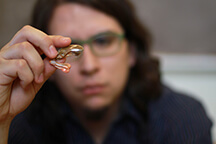Creature's 'dactyl club' filters shear waves to resist damage
June 16, 2015
 |
|
Purdue doctoral student Nicolás Guarín-Zapata holds a "dactyl club," the mantis shrimp uses to pummel the shells of hapless prey. New findings about the structure's natural design could lead to super composites. (Purdue University photo/Pablo Zavattieri) |
WEST LAFAYETTE, Ind. – The "smasher" peacock mantis shrimp is able to repeatedly pummel the shells of prey using a bizarre hammer-like appendage that, new research shows, can withstand rapid-fire blows by neutralizing certain frequencies of "shear waves."
The "dactyl club" can reach an acceleration of 10,000 Gs, unleashing a barrage of ferocious impacts with the speed of a .22 caliber bullet.
"The smasher mantis shrimp will hit many times per day. It is amazing," said Pablo Zavattieri, an associate professor in the Lyles School of Civil Engineering and a University Faculty Scholar at Purdue University.
The club is made of a composite material containing fibers of chitin, the same substance found in many marine crustacean shells and insect exoskeletons but arranged in a helicoidal structure that resembles a spiral staircase. This spiral architecture, new research findings show, is naturally designed to survive the repeated high-velocity blows by filtering out certain frequencies of waves, called shear waves, that are particularly damaging.
 |
|
Pablo Zavattieri, an associate professor in the Lyles School of Civil Engineering, at right, and doctoral student Nicolás Guarín-Zapata review CT scanning data of the dactyl club appendage used by the mantis shrimp to smash the shells of prey. Regions colored red represent high-density and blue low density. The club can reach an acceleration of 10,000 Gs, unleashing a barrage of ferocious impacts with the speed of a .22 caliber bullet. (Purdue University photo/Pablo Zavattieri) |
The findings could allow researchers to use similar filtering principles for the development of new types of composite materials.
"This is a novel concept," said David Kisailus, the Winston Chung Endowed Professor in Energy Innovation at the University of California, Riverside. "It implies that we can make composite materials able to filter certain stress waves that would otherwise damage the material."
Findings were detailed in a research paper published online May 14 and will appear in a future print issue of the journal Acta Biomaterialia.
The researchers modeled the structure with the same mathematical equations used to study materials in solid-state physics and photonics, showing the structure possesses "bandgaps" that filter out the damaging effects of shear waves traveling at the speed of sound.
Composites with this design structure could be used for a variety of applications, including aerospace and automotive frames, body armor and athletic gear including football helmets.
The paper's lead author was Purdue doctoral student Nicolás Guarín-Zapata and it was co-authored by Juan Gomez, a researcher from the Civil Engineering Department, Universidad EAFIT, Medellín, Colombia; doctoral student Nick Yaraghi from UC Riverside; Kisailus; and Zavattieri.
The research, which is ongoing and also will include efforts to create synthetic materials with filtering properties, has been funded by the National Science Foundation and the U.S. Air Force Office of Scientific Research.
Writer: Emil Venere, 765-494-4709, venere@purdue.edu
Source: Pablo Zavattieri, 765-496-9644, zavattie@purdue.edu
Note to Journalists: A copy of the research paper is available from Emil Venere, 765-494-4709, venere@purdue.edu
ABSTRACT
Shear wave filtering in naturally-occurring Bouligand structures
Nicolás Guarín-Zapata a, Juan Gomez b, Nick Yaraghi c, David Kisailus c,d, Pablo D. Zavattieri a,⇑
a Lyles School of Civil Engineering, Purdue University
b Civil Engineering Department, Universidad EAFIT, Medellín 050022, Colombia
c Materials Science and Engineering, University of California, Riverside
⇑ Corresponding author: zavattie@purdue.edu (P.D. Zavattieri)
Wave propagation was investigated in the Bouligand-like structure from within the dactyl club of the stomatopod, a crustacean that is known to smash their heavily shelled preys with high accelerations. We incorporate the layered nature in a unitary material cell through the propagator matrix formalism while the periodic nature of the material is considered via Bloch boundary conditions as applied in the theory of solid state physics. Our results show that these materials exhibit bandgaps at frequencies related to the stress pulse generated by the impact of the dactyl club to its prey, and therefore exhibiting wave filtering in addition to the already known mechanisms of macroscopic isotropic behavior and toughness.

